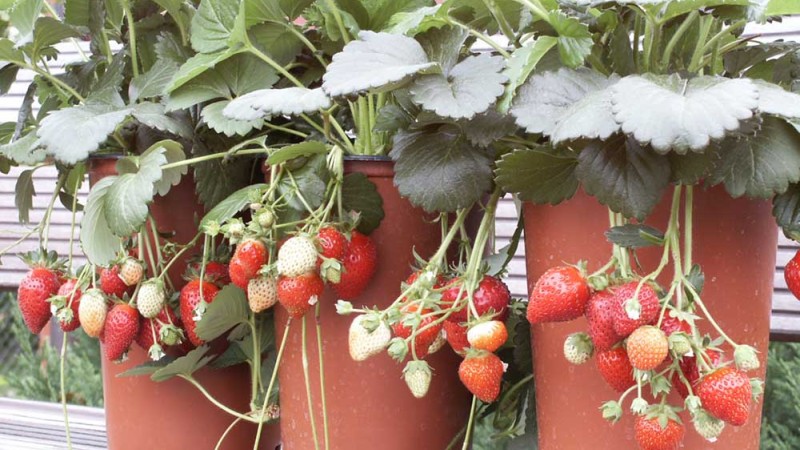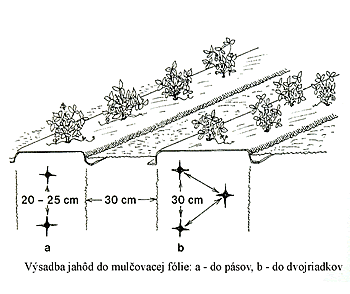
The garden strawberry (Fragaria × ananassa) is a hybrid plant grown worldwide for its delicious fruit. It was first bred in Brittany, France, in the 1750s via a cross of Fragaria virginiana from eastern North America and Fragaria chiloensis, which was brought from Chile by Amédée-François Frézier in 1714. The specific Latin name ananassa was given because the flavor of the hybrid was initially compared to pineapple.
Strawberries are very popular in home gardens for their pleasant aroma, juicy texture, fantastic taste, and natural sweetness. June-bearing strawberries, bear their fruit in the early summer and everbearing or remontant strawberries often bear several crops of fruit throughout the season. Strawberry cultivars vary widely in size, colour, flavour, shape, degree of fertility, season of ripening, liability to disease and constitution of plant. But strawberries aren't just for growing in the garden; they also bring joy to their owners on the balcony in hanging pots or window boxes. However, strawberries require year-round care until harvest.
Location and soil
Strawberries thrive in virtually all growing locations because they are easily adaptable. They prefer sunny locations and permeable loamy-sandy soil with a high humus content. Heavy soils pose a risk of root rot, which causes diseases to spread rapidly. Avoid growing strawberries repeatedly in the same bed. Strawberries should not remain in one location for more than three to four years.
Planting strawberries
Plant in pre-fertilized, weeded and loosened soil. Manure should be incorporated into the bed in the fall before planting. This allows most of the manure to decompose before planting and slowly release nutrients into the soil. The best time to plant is spring, due to the sufficient moisture and mild temperatures during this period. The second time is August and September. Before planting, only briefly immerse the roots in water. The distance between plants in a row is 30-40 cm. The rows should be 0.8 to 1 m apart. To retain moisture and prevent weed growth, we recommend using mulch fabric or strawberry cover foil.
Watering and fertilizing during the growing season
 Strawberries should be watered regularly during dry periods, as they have shallow roots that spread about 20 cm deep. Make sure that too much water does not get on the leaves, as this promotes the spread of diseases. In early spring, clean the strawberry stand of last year's vegetation residues. We recommend using granulated cow manure as the first fertilizer in the spring, and later granulated NPK fertilizer with microelements, in three doses during the growing season. If there is a longer dry period, use fertilizer irrigation.
Strawberries should be watered regularly during dry periods, as they have shallow roots that spread about 20 cm deep. Make sure that too much water does not get on the leaves, as this promotes the spread of diseases. In early spring, clean the strawberry stand of last year's vegetation residues. We recommend using granulated cow manure as the first fertilizer in the spring, and later granulated NPK fertilizer with microelements, in three doses during the growing season. If there is a longer dry period, use fertilizer irrigation.
Strawberry Diseases and Pests
Strawberries are susceptible to various diseases and pests that can significantly impact plant health and yield. Key diseases include gray mold (Botrytis cinerea), strawberry powdery mildew (Podosphaera aphanis), white leaf spot (Mycosphaerella fragariae) and various root and crown rots. Common pests include strawberry mite (Phytonemus pallidus) and the strawberry-blossom weevil (Anthonomus rubi). The strawberry mite can damage young strawberry leaves. Biological control is possible against this pest using predatory mites. To prevent strawberry pests and diseases, focus on good cultural practices like crop rotation, proper plant spacing and maintaining soil health. Ensure good air circulation and avoid overhead watering. Regularly remove leaf and fruit debris, monitor for pests and use appropriate biological products. For diseases, consider growing disease-resistant varieties.
Strawberry Propagation
You can easily propagate strawberries yourself using runners. After harvesting, choose strong and healthy runners that grow from the parent plant. You can plant the cut runners in boxes with a suitable substrate or directly in the strawberry patch. Remove excess runners, they weaken the plant.
Winterizing strawberries
Wintering is an important process that will ensure that the plants overwinter well and are strong and healthy in the spring. It includes protection from frost, drought and pests. Remove dry, damaged or infected leaves from the strawberry patch before frost arrives. This will reduce the risk of diseases and pests. In colder areas, it is important to cover the strawberry patch to protect it from frost. Suitable materials are straw, pine needles or garden fleece. Do not overdo it with covering, so that the strawberries do not start to rot at the core. During frost-free days, you can water the strawberries lightly.
Strawberries provide us with important vitamins and minerals
Strawberries are a source of a whole range of important vitamins. In the highest concentration, we find vitamin C, a powerful antioxidant and stimulant of our immunity. The content of vitamin C in strawberries is comparable to citrus fruits. They also contain folic acid and beta-carotene, the cornerstone for the synthesis of vitamin A, another antioxidant that protects our eyesight, gives our skin a healthy color and supports the regeneration of mucous membranes. To a lesser extent, strawberries also contain, for example, some B vitamins and vitamin E. Among the trace elements, manganese is certainly worth mentioning, an element that is necessary for blood formation, healthy tissues, brain and nerve nutrition, but also for the beauty and health of our skin and hair. Strawberries also contain, for example, fluorine, phosphorus and calcium. Another beneficial mineral in this fruit is potassium. This element supports the body's drainage, thus counteracting excessive fluid retention in the body (swelling) and stimulating the body's detoxification. Potassium also regulates blood pressure, and its increased intake is recommended to lower blood pressure.es.
Strawberries for body detoxification
We have already mentioned above that strawberries contain potassium, which helps us flush out accumulated toxins from the body. Another helper with internal cleansing are the tannins contained in strawberries, which bind toxic substances, especially heavy metals, to each other as they pass through our digestive tract and remove them. These tannins also support the elimination of infections, and also act against some viruses and bacteria. Strawberries are also attributed a beneficial effect in the treatment of gout, urinary and kidney stones.
Strawberries as a strengthening food during illness
Strawberries are also a suitable food in case of colds and respiratory diseases. They replenish necessary fluids (they contain up to 90% water), provide us with vitamins and minerals to increase immunity, help us fight the cause of infection or inflammation (sinuses, bronchi, etc.) and, through overall detoxification, make it easier for our body to fight the disease. In some cases, strawberries can also help us with diarrhea and flatulence, because they suppress some difficult bacteria in the intestines.







